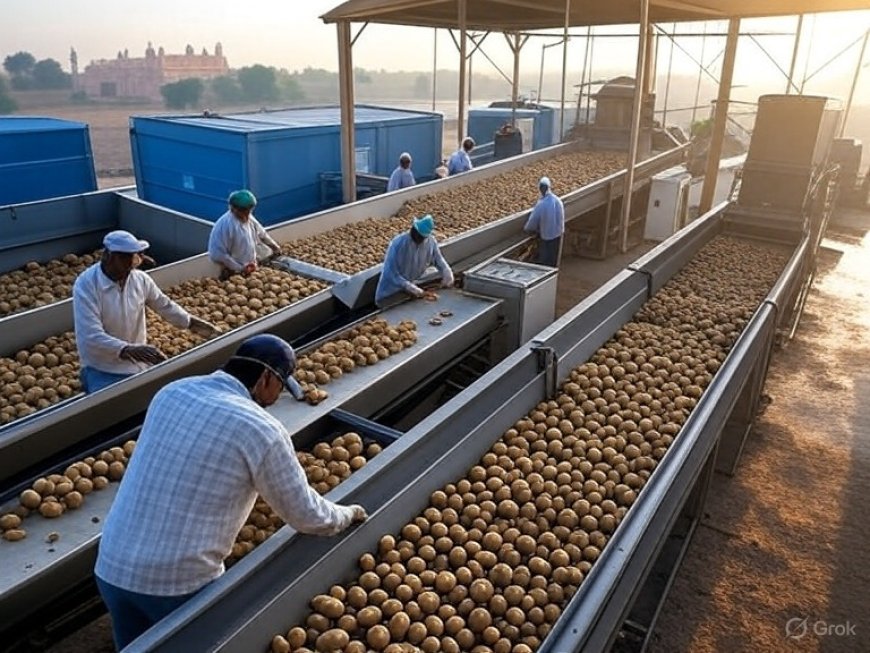Gujarat Leads India’s Potato Processing Revolution: Cold Chains, Export Growth, and a Chips Industry Boom
Gujarat leads India in processing-grade potato production, supported by cutting-edge cold-chain systems, exports, and food processing infrastructure. Learn how the state transformed the potato value chain.

Gandhinagar – Gujarat has emerged as the undisputed leader in India’s processing-grade potato sector, setting a benchmark for the rest of the country. With its cutting-edge cold-chain infrastructure, progressive farmer cooperatives, and a policy-friendly environment, the state now dominates the production of potatoes destined for high-value segments like frozen French fries, crisps, flakes, and dehydrated products.
This silent revolution in India's agricultural processing landscape is not only reducing India’s reliance on imports for frozen processed potato products but also fueling exports to Southeast Asia, the Middle East, and parts of Africa.
Gujarat: The Powerhouse of India’s Processing Potatoes
According to data from the Ministry of Agriculture and Farmers' Welfare, Gujarat contributes over 35% of India’s processing-grade potatoes, particularly varieties like Kufri Chipsona-1, Kufri Frysona, and Kufri Himsona. These are the preferred cultivars due to their low sugar and high dry matter content—essential traits for crisp, golden fries and chips.
While Uttar Pradesh and West Bengal are leaders in total potato production, Gujarat’s specialization in processing-grade quality gives it a competitive edge. The state has aligned agricultural research, mechanization, and industrial processing in a rare example of supply chain synergy.
The Mehsana, Banaskantha, Sabarkantha, and Aravalli districts are at the heart of this potato revolution.
Cold-Chain Infrastructure: The Backbone of Gujarat’s Success
A key enabler of Gujarat’s dominance is its world-class cold storage and logistics system, developed with public-private partnerships. The Gujarat State Agriculture Marketing Board (GSAMB), in collaboration with private players such as Keventer Agro, McCain Foods, and Balaji Wafers, has invested heavily in controlled atmosphere storage, allowing potatoes to be preserved for up to 10 months without sprouting or sugar buildup.
These high-tech storage units maintain temperatures between 2–4°C, critical for preserving quality for processing. In fact, Gujarat boasts over 2.5 million tonnes of cold storage capacity dedicated just to potatoes—an unmatched scale nationally.
This investment has drastically reduced post-harvest losses, which previously hovered around 18–20% in other potato-producing states, according to a report by NABARD.
Value-Addition Drives Economic Growth
The downstream effects of this agricultural transformation are profound:
-
Potato processing units, including fry plants and chip-making factories, have mushroomed in Gujarat.
-
Giants like McCain Foods India, Balaji Wafers, and ITC Limited have expanded operations here.
-
Over 30,000 direct jobs and 70,000 indirect jobs have been created, especially in rural belts.
Gujarat’s proactive approach in contract farming and minimum support pricing (MSP) for processing-grade potatoes ensures price security for farmers. Moreover, buy-back agreements with processors offer guaranteed off-take, reducing market uncertainty.
According to Invest India, the processed potato market in India is projected to grow at a CAGR of 12.5%, reaching ₹12,000 crore by 2028—with Gujarat expected to contribute nearly 60% of this growth.
Boosting Exports, Curtailing Imports
India has historically imported processed potato products, particularly from the Netherlands, Belgium, and Canada. However, Gujarat’s strides in quality and volume have begun reversing that trend.
In FY 2024-25:
-
India exported ₹1,120 crore worth of processed potato products, with Gujarat contributing over 62%.
-
Major export destinations included UAE, Oman, Malaysia, and Singapore.
-
Imports dropped by nearly 15% year-on-year, driven by domestic substitution.
The Agricultural and Processed Food Products Export Development Authority (APEDA) has lauded Gujarat’s agri-export zones, particularly in Banaskantha and Mehsana, as models for other states to replicate.
Research and Innovation: Foundation for Quality
Institutes like the Central Potato Research Station (CPRS), Deesa, and the Junagadh Agricultural University have played a pivotal role in:
-
Developing disease-resistant, high-yield potato varieties suited for Gujarat’s semi-arid conditions.
-
Training farmers in precision irrigation, fertigation, and crop rotation techniques.
-
Deploying AI-based sorting and sensor-based storage control systems.
The Gujarat Biotechnology Research Centre (GBRC) has also partnered with processors to develop starch-efficient potato breeds, tailored for industrial frying applications.
Environmental and Water-Efficient Practices
A lesser-known aspect of Gujarat’s success story is its environmentally conscious farming model. Since potatoes are water-intensive, Gujarat has pioneered:
-
Drip irrigation systems, reducing water use by up to 40%.
-
Solar-powered cold storages and renewable energy integration in logistics.
-
Zero-waste potato processing units, where peels and rejects are converted into animal feed or compost.
These sustainability practices have attracted green funding and climate-resilient agriculture grants from institutions like NABARD and the World Bank’s Agri Infra Fund.
Challenges and the Road Ahead
Despite its dominance, Gujarat’s potato sector faces challenges:
-
Climate vulnerability: Erratic weather patterns and rising temperatures could threaten yields.
-
Storage bottlenecks during bumper harvests remain a concern.
-
International competition: Global players like Canada and Belgium still dominate certain high-margin export markets.
To address these, the Gujarat government is focusing on:
-
AI-powered agri-climate forecasting tools.
-
Expanding cold storage capacity in Tier-2 towns and clusters.
-
Promoting public-private R&D partnerships for advanced processing.
A Model for Other Indian States
States like Punjab, Haryana, and Madhya Pradesh are sending delegations to Gujarat to study its potato success. In fact, the Ministry of Food Processing Industries (MoFPI) has listed Gujarat’s potato cold-chain and value-addition model as a best practice under the Pradhan Mantri Kisan Sampada Yojana (PMKSY).
Additionally, Gujarat’s integration of FPOs (Farmer Producer Organisations) into the processing chain is proving a game-changer, ensuring farmer ownership of value beyond the farm gate.
Final Thoughts
Gujarat’s story is a shining example of how infrastructure, innovation, policy, and entrepreneurship can transform a humble tuber into a global value-added commodity. The rise of processing-grade potatoes has not just empowered rural economies, but also carved a space for India in the competitive global processed foods market.
As India looks to enhance its agri-exports and reduce import dependency, Gujarat’s potato ecosystem offers a blueprint for future-ready agriculture—one rooted in efficiency, sustainability, and global competitiveness.



















































